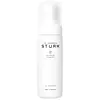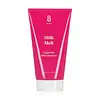What's inside
What's inside
 Key Ingredients
Key Ingredients

 Benefits
Benefits

 Concerns
Concerns

 Ingredients Side-by-side
Ingredients Side-by-side

Water
Skin ConditioningSodium Cocoamphoacetate
CleansingLauryl Glucoside
CleansingGlycerin
HumectantAloe Barbadensis Leaf Juice
Skin ConditioningSodium Cocoyl Glutamate
CleansingSodium Lauryl Glucose Carboxylate
CleansingPanthenol
Skin ConditioningUrea
BufferingLactobacillus/Portulaca Oleracea Ferment Extract
AntioxidantCitric Acid
BufferingBenzyl Alcohol
PerfumingPhenoxyethanol
PreservativePotassium Sorbate
PreservativeSalicylic Acid
MaskingLeuconostoc/Radish Root Ferment Filtrate
AntimicrobialTocopherol
AntioxidantPantolactone
HumectantSodium Benzoate
MaskingWater, Sodium Cocoamphoacetate, Lauryl Glucoside, Glycerin, Aloe Barbadensis Leaf Juice, Sodium Cocoyl Glutamate, Sodium Lauryl Glucose Carboxylate, Panthenol, Urea, Lactobacillus/Portulaca Oleracea Ferment Extract, Citric Acid, Benzyl Alcohol, Phenoxyethanol, Potassium Sorbate, Salicylic Acid, Leuconostoc/Radish Root Ferment Filtrate, Tocopherol, Pantolactone, Sodium Benzoate
Water
Skin ConditioningCaprylic/Capric Triglyceride
MaskingGlycerin
HumectantSodium Laurylglucosides Hydroxypropylsulfonate
CleansingColloidal Oatmeal
AbsorbentMaltooligosyl Glucoside
Skin ConditioningSodium Cocoamphoacetate
CleansingHydrogenated Starch Hydrolysate
HumectantAvena Sativa Kernel Oil
Skin ConditioningLauryl Glucoside
CleansingXanthan Gum
EmulsifyingPropanediol
SolventSodium Cocoyl Glutamate
CleansingSodium Lauryl Glucose Carboxylate
CleansingBenzyl Alcohol
PerfumingLactic Acid
BufferingSodium Chloride
MaskingSodium Cocoyl Hydrolyzed Oat Protein
Skin ConditioningCaprylic Acid
CleansingXylitol
HumectantTetrasodium Glutamate Diacetate
Tocopherol
AntioxidantCocos Nucifera Fruit Extract
EmollientLeuconostoc/Radish Root Ferment Filtrate
AntimicrobialLactobacillus Ferment
Skin ConditioningAgastache Mexicana Flower/Leaf/Stem Extract
Skin ConditioningButylene Glycol
HumectantWater, Caprylic/Capric Triglyceride, Glycerin, Sodium Laurylglucosides Hydroxypropylsulfonate, Colloidal Oatmeal, Maltooligosyl Glucoside, Sodium Cocoamphoacetate, Hydrogenated Starch Hydrolysate, Avena Sativa Kernel Oil, Lauryl Glucoside, Xanthan Gum, Propanediol, Sodium Cocoyl Glutamate, Sodium Lauryl Glucose Carboxylate, Benzyl Alcohol, Lactic Acid, Sodium Chloride, Sodium Cocoyl Hydrolyzed Oat Protein, Caprylic Acid, Xylitol, Tetrasodium Glutamate Diacetate, Tocopherol, Cocos Nucifera Fruit Extract, Leuconostoc/Radish Root Ferment Filtrate, Lactobacillus Ferment, Agastache Mexicana Flower/Leaf/Stem Extract, Butylene Glycol
 Reviews
Reviews

Ingredients Explained
These ingredients are found in both products.
Ingredients higher up in an ingredient list are typically present in a larger amount.
Benzyl Alcohol is most commonly used as a preservative. It also has a subtle, sweet smell. Small amounts of Benzyl Alcohol is not irritating and safe to use in skincare products. Most Benzyl Alcohol is derived from fruits such as apricots.
Benzyl Alcohol has both antibacterial and antioxidant properties. These properties help lengthen the shelf life of products. Benzyl Alcohol is a solvent and helps dissolve other ingredients. It can also improve the texture and spreadability.
Alcohol comes in many different forms. Different types of alcohol will have different effects on skin. This ingredient is an astringent alcohol.
Using high concentrations of these alcohols are drying on the skin. They may strip away your skin's natural oils and even damage your skin barrier. Astringent alcohols may also irritate skin.
Other types of astringent alcohols include:
According to the National Rosacea Society based in the US, you should be mindful of products with these alcohols in the top half of ingredients.
Any type of sanitizing product will have high amounts of alcohol to help kill bacteria and viruses.
Learn more about Benzyl AlcoholGlycerin is already naturally found in your skin. It helps moisturize and protect your skin.
A study from 2016 found glycerin to be more effective as a humectant than AHAs and hyaluronic acid.
As a humectant, it helps the skin stay hydrated by pulling moisture to your skin. The low molecular weight of glycerin allows it to pull moisture into the deeper layers of your skin.
Hydrated skin improves your skin barrier; Your skin barrier helps protect against irritants and bacteria.
Glycerin has also been found to have antimicrobial and antiviral properties. Due to these properties, glycerin is often used in wound and burn treatments.
In cosmetics, glycerin is usually derived from plants such as soybean or palm. However, it can also be sourced from animals, such as tallow or animal fat.
This ingredient is organic, colorless, odorless, and non-toxic.
Glycerin is the name for this ingredient in American English. British English uses Glycerol/Glycerine.
Learn more about GlycerinLauryl Glucoside sugar- and lipid-based cleansing agent. It is created from glucose and lauryl alcohol.
This ingredient is a surfactant, making it easier to rinse oil, dirt, and other pollutants away.
A British study found lauryl glucoside to cause skin sensitivity for some people. We recommend speaking with a professional if you have concerns.
Other names for this ingredient include "Lauryl Polyglucose", "Lauryl glycoside", and "D-Glucopyranoside".
Learn more about Lauryl GlucosideLeuconostoc/Radish Root Ferment Filtrate is a natural preservative. It comes from fermenting radish roots with a bacteria called leuconostoc.
Leuconostoc comes from lactic acid.
This ingredient has antimicrobial properties and helps prevent the growth of bacteria in a product.
Leuconostoc is used to make the traditional Korean side-dish, kimchi. It is also used to make sourdough bread (both incredibly yummy foods).
Learn more about Leuconostoc/Radish Root Ferment FiltrateWe don't have a description for Sodium Cocoamphoacetate yet.
Sodium Cocoyl Glutamate is a gentle cleanser and surfactant. It is the sodium salt of the Cocoyl Glutamic Acid and comes from coconut oil. As a surfactant, it helps lift dirt and oil to be washed away.
Sodium Cocoyl Glutamate also has an emolliating effect and can help leave the skin feeling soft.
We don't have a description for Sodium Lauryl Glucose Carboxylate yet.
Tocopherol (also known as Vitamin E) is a common antioxidant used to help protect the skin from free-radicals and strengthen the skin barrier. It's also fat soluble - this means our skin is great at absorbing it.
Vitamin E also helps keep your natural skin lipids healthy. Your lipid skin barrier naturally consists of lipids, ceramides, and fatty acids. Vitamin E offers extra protection for your skin’s lipid barrier, keeping your skin healthy and nourished.
Another benefit is a bit of UV protection. Vitamin E helps reduce the damage caused by UVB rays. (It should not replace your sunscreen). Combining it with Vitamin C can decrease sunburned cells and hyperpigmentation after UV exposure.
You might have noticed Vitamin E + C often paired together. This is because it is great at stabilizing Vitamin C. Using the two together helps increase the effectiveness of both ingredients.
There are often claims that Vitamin E can reduce/prevent scarring, but these claims haven't been confirmed by scientific research.
Learn more about TocopherolWater. It's the most common cosmetic ingredient of all. You'll usually see it at the top of ingredient lists, meaning that it makes up the largest part of the product.
So why is it so popular? Water most often acts as a solvent - this means that it helps dissolve other ingredients into the formulation.
You'll also recognize water as that liquid we all need to stay alive. If you see this, drink a glass of water. Stay hydrated!
Learn more about Water